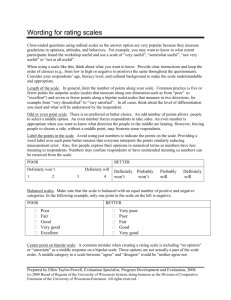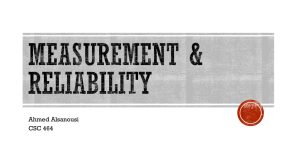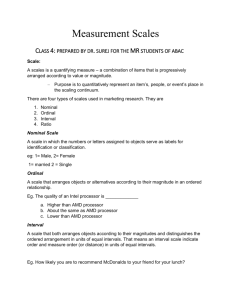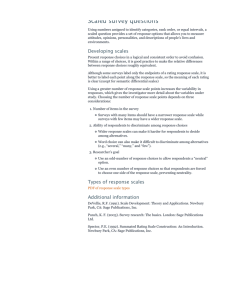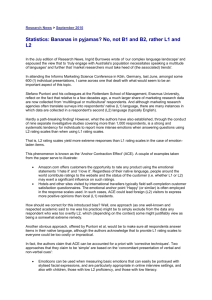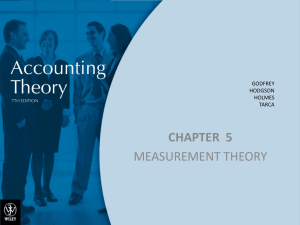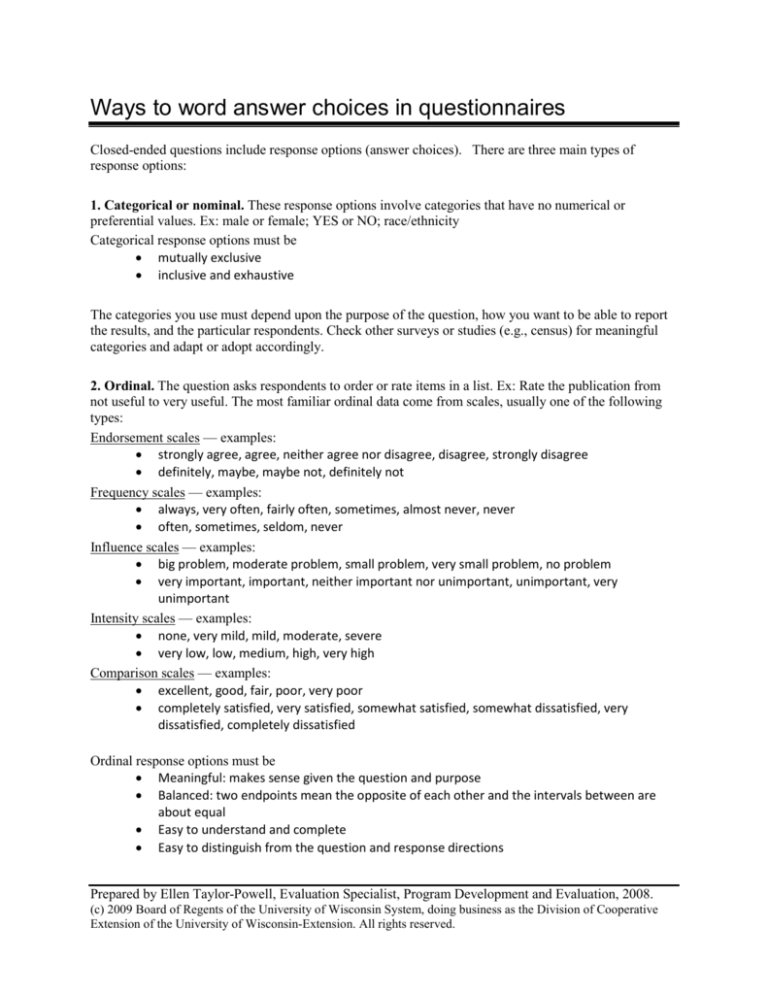
Ways to word answer choices in questionnaires
Closed-ended questions include response options (answer choices). There are three main types of
response options:
1. Categorical or nominal. These response options involve categories that have no numerical or
preferential values. Ex: male or female; YES or NO; race/ethnicity
Categorical response options must be
• mutually exclusive
• inclusive and exhaustive
The categories you use must depend upon the purpose of the question, how you want to be able to report
the results, and the particular respondents. Check other surveys or studies (e.g., census) for meaningful
categories and adapt or adopt accordingly.
2. Ordinal. The question asks respondents to order or rate items in a list. Ex: Rate the publication from
not useful to very useful. The most familiar ordinal data come from scales, usually one of the following
types:
Endorsement scales — examples:
• strongly agree, agree, neither agree nor disagree, disagree, strongly disagree
• definitely, maybe, maybe not, definitely not
Frequency scales — examples:
• always, very often, fairly often, sometimes, almost never, never
• often, sometimes, seldom, never
Influence scales — examples:
• big problem, moderate problem, small problem, very small problem, no problem
• very important, important, neither important nor unimportant, unimportant, very
unimportant
Intensity scales — examples:
• none, very mild, mild, moderate, severe
• very low, low, medium, high, very high
Comparison scales — examples:
• excellent, good, fair, poor, very poor
• completely satisfied, very satisfied, somewhat satisfied, somewhat dissatisfied, very
dissatisfied, completely dissatisfied
Ordinal response options must be
• Meaningful: makes sense given the question and purpose
• Balanced: two endpoints mean the opposite of each other and the intervals between are
about equal
• Easy to understand and complete
• Easy to distinguish from the question and response directions
Prepared by Ellen Taylor-Powell, Evaluation Specialist, Program Development and Evaluation, 2008.
(c) 2009 Board of Regents of the University of Wisconsin System, doing business as the Division of Cooperative
Extension of the University of Wisconsin-Extension. All rights reserved.
Considerations:
• Use a neutral response category only if it is makes sense; distinguish undecided (or no
opinion) from neutral by placing undecided (or no opinion) at end of scale.
• Think about the number of points on the scale: 4- to 5-point scales most common; depends
whether the question is in a self-administered questionnaire, phone interview, or in-person.
There is no conclusive evidence about whether an odd- or even-numbered scale is better —
depends upon the question and your needs.
• Consider placing the negative end of the scale first in potentially embarrassing or socially
sensitive questions.
• Cluster response options. If several questions use the same response options, place the
items together in one question (example).
3. Numerical. The question asks respondents for a number such as age, height or the number of times you
went to the movies last month.
Helpful resource: Fink, A. (2003). Responses: Choices and measurements. In How to ask
survey questions (2nd ed.) (Chapter 3). Thousand Oaks, CA: Sage Publications, Inc.
Prepared by Ellen Taylor-Powell, Evaluation Specialist, Program Development and Evaluation, 2008.
(c) 2009 Board of Regents of the University of Wisconsin System, doing business as the Division of Cooperative
Extension of the University of Wisconsin-Extension. All rights reserved.


